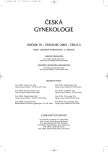Changes in Vesicalization of Urethra and Bladder after TVT Operation
Změny vezikalizace uretry a močového měchýře po TVT operaci
Cíl studie:
Cílem této studie bylo zjistit změny proximální uretry (vezikalizace) a stěny močového měchýře po úspěšně provedené TVT operaci.
Typ studie:
Prospektivní pilotní studie.
Název a sídlo pracoviště:
Gynekologicko – porodnická klinika VFN a 1. LF UK, Praha. Euromise
Centrum, Karlova univerzita a Akademie věd ČR, Praha.
Metodika:
Do prospektivní studie bylo vyhodnoceno 90 žen po úspěšně provedené TVT operaci (z původních
zařazených 101 žen s prokázanou stresovou inkontinencí). UZ vyšetření bylo provedeno před operací
a 3–6 měsíců po operaci v rámci kompletního urogynekologického vyšetření. Vedle mobility uretry byla
hodnocena vezikalizace uretry v klidu a při maximálním Valsalvově manévru (šířka a hloubka). Zároveň
byla změřena tloušťka stěny močového měchýře na 3 místech, přední stěna, trigonum a fundus.
Vyhodnoceny byly změny vyvolané operací. K statistickému zpracování byl použit t-test, Wilcoxonův test.
Výsledky:
Operace neovlivňuje proximální uretru (vezikalizaci) v klidu. Signifikantně snižuje vezikalizaci
při Valsalvově manévru (hloubku i šířku). Po operaci se lehce zvyšuje tloušťka stěny močového měchýře
(přední stěny a trigona).
Závěr:
Vliv TVT na uretru je mnohem komplexnější než pouhá komprese středu uretry. Ovlivňuje i proximální
uretru v průběhu Valsalvova manévru, kdy signifikantně snižuje vezikalizaci.
Klíčová slova:
introitální ultrazvuk, inkontinence moči, TVT, vezikalizace
Authors:
J. Mašata 1; A. Martan 1
; K. Švabík 1; P. Drahorádová 1; M. Pavlikova 2; J. Hlásenská 2
Authors‘ workplace:
Gynekologicko-porodnická klinika VFN a 1. LF UK, Praha, přednosta prof. MUDr. A. Martan, DrSc.
1; Euromise centrum, Karlova univerzita a Akademie věd ČR, Praha, ředitelka prof. RNDr. J. Zvárová, DrSc.
2
Published in:
Ceska Gynekol 2005; 70(4): 276-280
Category:
Original Article
Overview
Objective:
The aim of our study was to asses the changes of the funnelling and the thickness of the urinary bladder after successful TVT procedure.
Design:
Prospective pilot study.
Setting:
Obstet. Gynecol Department, General Teaching hospital, Ist Medical Faculty, Charles University, Prague. EuroMISE Centre of the Charles University and Academy of Sciences, Prague, Czech Republic.
Methods:
In the prospective study were evaluated 90 women after successful TVT procedure (in the study was primarily included 101 women with proven stress urinary incontinence). Ultrasound scan was performed before surgery and 3–6 months after operation as a part of the complex urogynecological examination. Together with urethral mobility was assessed the funnelling at rest and at maximal Valsalva (the width and depth of visible opening of the proximal urethra). Thickness of the bladder wall was measured after emptying of the urinary bladder at three points (anterior, trigone and dome). The changes induced by the surgery were assessed. For the statistical evaluation t-test and Wilcoxone test were used.
Results:
The operation did not influence the proximal urethra at rest and significantly decreased funnelling during maximal Valsalva (width and depth). After the surgery there was a slight increase in the thickness of the bladder wall (anterior and trigone by 0.4 mm).
Conclusions:
The action of the tape is more complex that only the compression of the urethra. The tape influenced the proximal urethra at maximal Valsalva, significantly decreased the funnelling.
Key words:
introital ultrasound, stress urinary incontinence, TVT, bladder neck, funnelling
Labels
Paediatric gynaecology Gynaecology and obstetrics Reproduction medicineArticle was published in
Czech Gynaecology

2005 Issue 4
Most read in this issue
- Prenatal Parvovirus B19 Infection in Fetus
- The Detection of p16 Protein in Uterine Cervix Lesions
- Changes in Vesicalization of Urethra and Bladder after TVT Operation
- Antibiotics prophylaxis in laparoscopy
